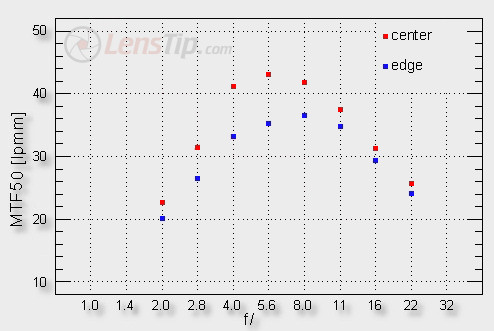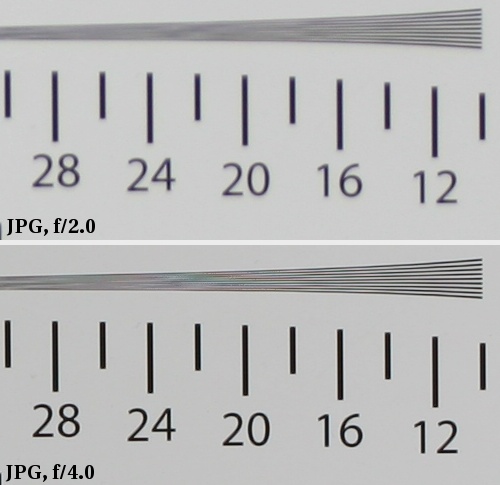Canon EF 35 mm f/2.0
4. Image resolution

One of the most important advantages of the Canon EF 2/35 mm can be noticed almost immediately. None of the other kit lens equivalents is equipped with f/2.0 aperture. How does the Canon perform at this aperture? Unfortunately, quite poorly. The result of 22.6 mm in the center of the frame is a fairly weak outcome. So the potential and very important virtue of the lens has been compromised from the very beginning.
However, when stopping down the lens, the situation improves very quickly. At f/2.8 the Canon’s results reach 31.7lpmm, which is a good result. The situation on the market is favorable for Canon, since many of the equivalents are already equipped with f/2.8 and have good results at the 35 mm range. As an example, Tamron’s MTF 17-50 mm reaches 36lpmm, Sigma’s18-50 mm - 33lpmm. So The Canon 2/35 with results of 32lpmm does not look fantastic at all.
Please Support UsIf you enjoy our reviews and articles, and you want us to continue our work please, support our website by donating through PayPal. The funds are going to be used for paying our editorial team, renting servers, and equipping our testing studio; only that way we will be able to continue providing you interesting content for free. |
- - - - - - - - - - - - - - - - - - - - - - - - - - - - - - - - - - - - - - - - - - - - - - - -
Only when using f/4.0 to f/8.0 diaphragms can we definitely see that the fixed focal length of Canon’s EF2/35 results are much higher than those of zoom cameras. Here, the problem is that the battle takes place on a higher level and in every day situations the difference between the 40lpmm and 43lpmm is unnoticeable (adding the measuring/testing errors). Both pictures are very sharp and this is the most important thing indeed.
Another category, in which the fixed focal length lenses are better than the zooms is the performance at the edge of the frame. While many good varifocal lenses are able to reach the same results in the middle of the frame, the performance at the edge of the frame is weaker than for fixed lenses.
In Canon’s E2/35 case the edge of the frame for f/2.0 and f/2.8 does not look impressive. The MTFs here reach, respectively, 20.3 and 26.2lpmm. At f/4.0, however, the Canon’s results are good and at the f/5.6-f/11 the results are very good. What is the situation for the aforementioned f/2.8 kit equivalents? The Tamron 17-50 mm does not look that bad although its results at any aperture are much weaker than the Canon’s. The Sigma 18-50 f/2.8 Marco is clearly defeated with its result of less than 30lpmm.
To sum it up, the Canon EF 2/35 had a great chance to dominate the zoom lenses, thanks to its better aperture, better center of frame performance and better performance at the edges of the frame. It looks like it succeeded only in the last one…







